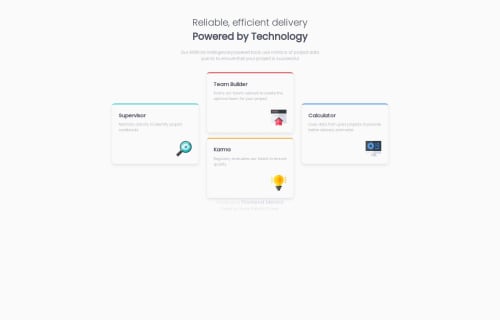Four card feature section [HTML & SASS]

Solution retrospective
To make it look as similar as I could to the design, I'm sure there are other ways and at one point I thought it would end up ugly, but it turned out pretty :D
What challenges did you encounter, and how did you overcome them?The first was that I read that sass was used for CSS and the truth is that it is a very interesting support, I'm sure it can be used better, then the cards, I tried several ways but in the end it looked good with Grid, it also needed quite a bit of responsiveness, I have to review how to review it better at "local"
What specific areas of your project would you like help with?Mmm, in the responsive sizes, I would like everything to maintain a scale and decrease or increase it, I wonder if it is possible, and if it is, it may not be as simple as I imagine XD
Please log in to post a comment
Log in with GitHubCommunity feedback
- P@Rahexx
Good job on this challenge! I agree that the result looks nice and is close to the original design. Although it’s a slightly smaller version, with more practice, I'm confident your skills will improve, and your applications will get even closer to the design specifications.
Here are a few tips that might be useful:
- Consider using the BEM methodology for naming classes. Names like "L1" or "L2" don’t convey much meaning, so using BEM can make your classes more descriptive and maintainable. (BEM 101)[https://css-tricks.com/bem-101/]
- Limit the use of
h1tags to one per page. Anh1represents the main title of the page, so avoid using multipleh1tags. Instead, use smaller headings likeh2orh3where needed. - Remember to use descriptive
altattributes for accessibility. For instance, "Supervisor_Icon" doesn’t provide much information to visually impaired users. Instead, a description like "magnifying glass with an eye inside" would be more helpful. - Consider using semantic HTML tags such as
sectioninstead of adivfor a card. This can improve the semantic structure of your page. - Great job using
@mixins! To take this further, try reading about responsive design breakpoints. By setting multiple breakpoints and adapting styles progressively, you’ll achieve a layout that’s even closer to the design on all screen sizes. Overall, great job!
Marked as helpful
Join our Discord community
Join thousands of Frontend Mentor community members taking the challenges, sharing resources, helping each other, and chatting about all things front-end!
Join our Discord